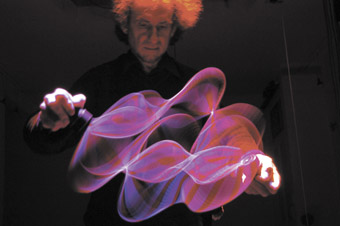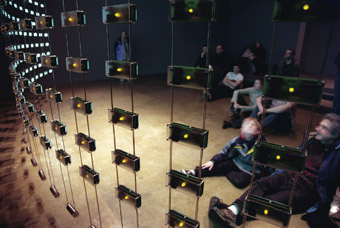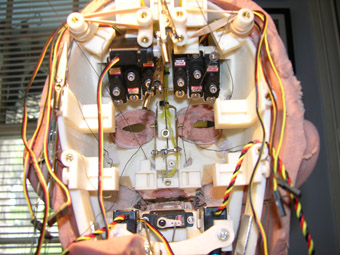wonder, beyond categories
jacqueline millner: souls & machines, madrid

Wave Function (2007), Paul Friedlander
courtesy the artist
Wave Function (2007), Paul Friedlander
WONDER IS THAT AESTHETIC EXPERIENCE CHARACTERISED BY THE PLEASURE OF AMAZEMENT, ADMIRATION AND DELIGHT IN THE QUALITIES OF A THING, A FEELING OF THE FRESHNESS OF THE WORLD. RENÉ DESCARTES DESCRIBED IT IN HIS PASSIONS OF THE SOUL AS “A SUDDEN SURPRISE OF THE SOUL THAT BRINGS IT ABOUT THAT THE SOUL GOES ON TO CONSIDER WITH ATTENTION OBJECTS THAT ARE RARE AND EXTRAORDINARY TO IT…IT MAKES US LEARN AND RETAIN IN OUR MEMORY THINGS THAT UNTIL THEN WE WERE IGNORANT OF.” WONDER OFTEN HAS AT LEAST TWO MOMENTS, THE FIRST PLEASURE OF SURPRISE THAT IS MORE STRONGLY SOMATIC, IMMEDIATE AND UNREFLECTIVE—THE ‘AH!’ OF WONDER—AND THE SECOND THAT IS MORE STRONGLY INTELLECTUAL, THE DRIVE WITHIN WONDER TOWARD CURIOSITY, QUESTIONING AND THE SEARCH FOR EXPLANATION.
American philosopher Philip Fisher argues that wonder, or “the aestheticisation of delight”, is “the most neglected of primary aesthetic experiences within modernity”, a movement more often characterised in terms of the terror of the sublime. It is an aesthetic experience he (along with several other philosophers and art theorists in recent times) seeks to revalorise, for contrary to the sensations of privation and fear characterised by the sublime, in wonder the beholder’s perception is ego-transcending and unselfish, at times so struck by a thing’s originality that preconceptions or a definite goal or purpose fall away. In wonder, the world is seen as beautiful, cognition is more receptive, and the viewer is more open to new ideas.
I begin with this short (apparent) digression on the philosophy of wonder because it was my primary aesthetic experience on visiting the latest temporary exhibition in Madrid’s renowned museum of modern and contemporary art, the Centro de Arte Reina Sofia. Máquinas & Almas (Souls & Machines) may come packaged in rhetoric reminiscent of ‘new media’ technophilia of the 1990s—transformation, connectivity, interactivity—yet most of the works elude these curatorial constraints with élan, striking the viewer with a wonder that leads to an enlivened and broadened thinking about the world in general, not just the role of technology and its impact. And together with that broadened thinking comes a sense of genuine delight at the ingenuity and creativity of the makers (a feeling that does not mark one’s exit from an exhibition of contemporary art often enough!).
In a dim room, a round pool of dense black oil suddenly springs to life: conical bubbles surge in formation to the surface, rising to an implausible height, creating ambiguous impressions in constant movement: miniature cities, lunar landscapes, or microorganisms multiplying in agar. At first, wonderment triggers pleasurable flights of fancy, before pricking the curiosity and releasing the pleasure of intellectual inquiry: could the forms be caused by magnetic fields interacting with iron filings? Saciko Kodoma’s Protrude, Flow (2001-2008) is in fact one instance of a large body of work in which the artist uses computers to regulate the movement of metallic fluid—as in electronics and medical diagnostic tools—by magnetic forces. The viewers’ process of inquiry eventually leads them to realise that it is their voices and ambient noise that causes the fluids to change form. The work renders invisible digital networks tangible, imbricating the viewer in that network in a way that ultimately becomes comprehensible.
The subtlety of Kodoma’s interface and the work’s potent embodiment of digital networks in formal elegance are evident in a number of works here (no ‘drag and click’ anywhere, thankfully!). Daniel Rozin’s ‘mirror works’ recall the theatre warm-up game where one actor follows the actions of another as in a mirror reflection. However, standing opposite us is not another person but a mechanical ‘canvas’ composed of a formal amalgam of small parts that swivel and click into position to reflect our movements, not unlike stadium cards. That each part is a recognisable object in its own right, either a graphic disc, or, in Rozin’s most amusing kinetic sculpture Trash Mirror (2002-2008), individual pieces of rubbish picked up off a New York street, renders the canvas’ transformation into a screen even more astounding. The work offers a physical analogue of the pixel that helps the viewer cognise the ‘mysterious’ process of digital image making. The revelation of the intricate working mechanisms—a nest of wires and circuit boards encased in Perspex behind each piece transforms real time video into motion calibrated to a grey scale—doubles the delight the audience takes in playing ‘follow’ with what first appears to be an abstract painting. This play between mediums of representation—painting, photography, video and computer graphics—and their respective relationship to human subjectivity further enhances the viewer’s engagement with Rozin’s work.

Listening Post (2006), Ben Rubin, Mark Hansen
courtesy the artists
Listening Post (2006), Ben Rubin, Mark Hansen
Yet another work that gives material presence to ‘immaterial’ computer networks—specifically social and communication networks—with humour and ingenuity is Ben Rubin and Mark Hansen’s Listening Post (2002-2006). A collaboration between an artist and a professor of statistics, this large-scale installation comprises several hundred LED panels that transmit in real time choice phrases from internet chat room conversations. As the panels flicker ‘Korea will be delt [stet] with by China and Russia I bet’, or ‘Toothless blonde, whoever you are, you made my day’, and a digitised HAL-like voice reads selections out loud, the viewer is literally immersed in the network, imparted with a physical sense of being inside other people’s intimate thoughts and desire to connect. Whether the exchanges be facile and banal, or poignant and revelatory, the installation presents their variety and density in such a manner as to inspire awe in human communication and imagination, and of course in the capacity of computer networks to facilitate this connectivity: this is truly a wonderful work.

Song for Julio (2008), David Byrne, David Hanson
courtesy the artists
Song for Julio (2008), David Byrne, David Hanson
Philip Fisher’s treatise on wonder centres around the drive to explain that most wonderful of natural phenomena, the rainbow; it is the rainbow’s awe-inspiring beauty that sparks its investigation. This conjunction of scientific inquiry and aesthetics permeates this exhibition. Trained as an artist and a physicist, Paul Friedlander practiced for many years as a lighting designer for major theatrical events before devoting himself to art. His spectacular kinetic light installations (including Abstract Cosmology, 2008), where again a purportedly immaterial medium is rendered concrete, demonstrate the intricate links between these disparate discourses. Theo Jansen’s kinetic sculptures, such as Animaris Modularis (2008), also represent a cross-over between art and science: the artist builds animal-like structures from electrical ducting which are then ‘evolved’ into ‘intelligent’ creatures through a combination of computer programming and field testing (on the windy beaches of Holland). Musician and Renaissance man David Byrne lent his voice to robotics expert David Hanson’s sophisticated specimen to create an eerily ‘alive’ synthetic character, Julio (2008), who ahhs and umms, clears his throat, and looks self-consciously around before breaking into heart-felt song.
Thoughtfully and accessibly installed—the number of works is not overwhelming, there are beanbags to encourage longer contemplation, and the works are well-separated through lighting and screens—Souls & Machines brings together an exceptional selection of works that I would argue go beyond the ‘new media’ categorisation. Rather, the best works here spark wonder, leading the viewer from surprise, through to curiosity and understanding, not only about the impact of digital technologies but more broadly about the current nature of human perception, relationships and our being in the world.
Máquinas & Almas (Souls & Machines), curators Montxo Algora and Jose Luis de Vicente, artists Antoni Abad; David Byrne and David Hanson; Daniel Canogar; Vuk Cosic; Evru; Harun Farocki; Paul Friedlander; Pierre Huyghe; Theo Jansen; Natalie Jerimijenko and Angel Borrego; Sachiko Kodama; Rafael Lozano-Hemmer; John Maeda; Chico MacMurtie/Amorphic Robot Works; Antoni Muntadas; Daniel Rozin; Ben Rubin and Mark Hansen; Museo Nacional Centro de Arte Reina Sofia, Madrid, June-October
RealTime issue #88 Dec-Jan 2008 pg. 24






